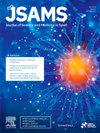Handball playing volume and knee injury risk in youth handball: the influence of sex
IF 3
2区 医学
Q1 SPORT SCIENCES
引用次数: 0
Abstract
Objectives
To investigate if sex modifies the association between change in weekly handball volume and knee injury risk in youth handball players.
Design
Prospective cohort study.
Methods
679 players aged 14-18 reported weekly on any new handball-related knee injury and handball volume (training and competition hours) over 31 weeks through the SMS, phone and medical examination system. Weekly handball volume was categorized based on changes relative to the exponentially weighted moving average of handball volume the preceding four weeks: (1) less than 20% increase or decrease (reference group), (2) 20% and 60% increase and (3) increase greater than 60%. Players indicated their sex as a part of their baseline survey, identifying as either a female player or male player.
Results
Female players who increased their weekly handball volume by over 60 % had a knee injury risk of 31.2 % (95% confidence interval: 21.6–40.8 %) the following week compared to female players who increased their handball volume below 20 %, which was higher than that in male players whose risk was 10.5 % (95 % confidence interval: 2.1–18.8 %) corresponding to a risk difference of 20.6 %-points (95 % confidence interval: 6.5–34.6 %-points).
Conclusions
Female handball players aged 14–18 years were more susceptible to a handball-related knee injury following weeks with large increases in handball volume compared with age-identical males, suggesting a previously unexplored association between sex-related differences in load tolerance and knee injury risk that warrant further investigation. The provided cut points for increases in handball volume should be interpreted and used with caution.
青少年手球运动量与膝部损伤风险:性别的影响。
目的:探讨性别是否会改变青少年手球运动员每周手球量变化与膝关节损伤风险之间的关系。设计:前瞻性队列研究。方法:通过短信、电话和体检系统,每周报告679名14-18岁球员31周内发生的新手球膝部损伤和手球量(训练和比赛时间)。每周手球量根据相对于前四周手球量指数加权移动平均值的变化进行分类:(1)增加或减少少于20%(参照组),(2)增加20%至60%,(3)增加大于60%。玩家将自己的性别作为基线调查的一部分,确定为女性玩家或男性玩家。结果:每周手球量增加60%以上的女运动员下一周膝盖损伤的风险为31.2%(95%可信区间:21.6 ~ 40.8%),高于手球量增加20%以下的男运动员下一周膝盖损伤的风险为10.5%(95%可信区间:2.1 ~ 18.8%),风险差异为20.6%(95%可信区间:6.5 ~ 34.6%)。结论:14-18岁的女性手球运动员在手球量大幅增加的几周后,比同龄的男性手球运动员更容易发生手球相关的膝盖损伤,这表明先前未被探索的负荷耐受性性别差异与膝盖损伤风险之间的关联值得进一步研究。手球量增加的截点应谨慎解释和使用。
本文章由计算机程序翻译,如有差异,请以英文原文为准。
求助全文
约1分钟内获得全文
求助全文
来源期刊
CiteScore
7.40
自引率
10.00%
发文量
198
审稿时长
48 days
期刊介绍:
The Journal of Science and Medicine in Sport is the official journal of Sports Medicine Australia (SMA) and is an an international refereed research publication covering all aspects of sport science and medicine.
The Journal considers for publication Original research and Review papers in the sub-disciplines relating generally to the broad sports medicine and sports science fields: sports medicine, sports injury (including injury epidemiology and injury prevention), physiotherapy, podiatry, physical activity and health, sports science, biomechanics, exercise physiology, motor control and learning, sport and exercise psychology, sports nutrition, public health (as relevant to sport and exercise), and rehabilitation and injury management. Manuscripts with an interdisciplinary perspective with specific applications to sport and exercise and its interaction with health will also be considered.

 求助内容:
求助内容: 应助结果提醒方式:
应助结果提醒方式:


